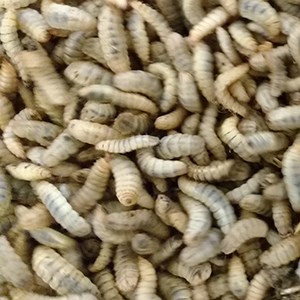Fakta:
This project will commence later this year and is expected to continue until 2021. This project is funded by the Swedish research council Formas.

This project aims to investigate the potential use of live soldier fly larvae (Hermetia illucens) as a novel environmental enrichment to promote food foraging behaviours and reduce feather pecking in laying hens. A secondary aim, is to utilize fly larvae, grown in Sweden using local organic blue mussel by-products, as an alternative food source for poultry to reduce reliance on imported proteins (such as soy).
Under natural conditions, poultry spend most of the day pecking and scratching for a varied diet including plants, seeds and live insects and larvae. The strong motivation to spend most of the day pecking and foraging for food is still very much present in domestic laying hens. However, this behaviour is less relevant for domestic birds since in commercial situations, birds are confined to an enclosed space and fed a pellet diet, which the birds are able to consume in a very short time. Providing food in pellet form is highly efficient since it reduces food selection and waste while providing nutrients required to maintain egg production. While this is ideal for production, it is not for the welfare of the birds. Being able to consume their daily food intake in a very short time allows hens to spend a large part of their day engaging in non-food directed pecking activities (e.g. pecking feathers and other birds). This increases the risk of severe feather pecking and cannibalism. For this reason, the aim of this project is to investigate the use of live soldier fly larvae (Hermetia illucens) as a novel environmental enrichment to promote food foraging behaviours and reduce feather pecking in laying hens. A secondary aim, is to utilize fly larvae, grown in Sweden using local organic blue mussel by-products, as an alternative food source for poultry. This is an extension to our current work using fly larvae as a food source for fish (funded by Interreg, Baltic Sea Region).
Anders Kiessling, Helena Wall, Torbjörn Lundh, Björn Vinnerås (Department of Energy and Technology, Environmental Engineering Unit)
This project will commence later this year and is expected to continue until 2021. This project is funded by the Swedish research council Formas.